
Designing the Type-12 Shuttlecraft - By Rick Sternbach.
In Star Trek: Voyager's second season, senior illustrator Rick Sternbach was given the chance to revisit the
design of the Starfleet shuttle and create a sleek new version for Captain Janeway's ship.
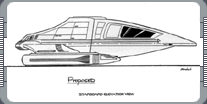 Toward the end of Star Trek: Voyager's second season, the producers sent the art department a memo asking them
to design a "cool and sleek shuttle." A new shuttle had been on their wish list for some time, but until now
there hadn't been a compelling reason to build one. But the next episode in production, 'Threshold,' justified
the expense. The story dealt with a specially modified shuttlecraft that could achieve warp 10, something the
traditional shuttle just didn't seem capable of.
Toward the end of Star Trek: Voyager's second season, the producers sent the art department a memo asking them
to design a "cool and sleek shuttle." A new shuttle had been on their wish list for some time, but until now
there hadn't been a compelling reason to build one. But the next episode in production, 'Threshold,' justified
the expense. The story dealt with a specially modified shuttlecraft that could achieve warp 10, something the
traditional shuttle just didn't seem capable of.
Voyager's resident illustrator Rick Sternbach remembers that he was particularly pleased by the project. "New
hardware was always welcome at my desk, so I began working up preliminary hull shapes while Richard James and
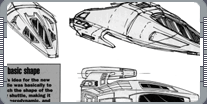 the set designers, particularly John Chichester, developed the interior. I got the ball rolling on a few
interior sketches, showing the producers early on how the cockpit might accommodate two seats, two seats plus a
folding jumpseat, or four seats. We knew that 'cool and sleek' was going to mean long, low, and streamlined,
but we also had to insure that our actors could stand up inside, so the minimum ceiling height was kept at almost
six feet. If we were required to make the speedboat as sleek as, say, a Lotus or Ferrari automobile, they'd
have to crouch inelegantly to enter their seats." Remarkably, the new shuttle, which the art department dubbed
the 'speedboat,' was the first major redesign the shuttles had undergone since the first season of Star Trek:
The Next Generation. As Sternbach explains, until now the previous 'new shuttles' had been modifications of the
same basic ship. "When we began Voyager we had the TNG shuttle, which was given an improved cabin, and even one
modification to the exterior, though that was seen only in a miniature for one or two episodes. True to the
Star Trek phrase 'like nothing we've seen before,' the speedboat was custom build inside and out. With the
exception of the sports car seats, the set construction was new. It followed Starfleet design, of course, in
that it had the familiar light-up consoles and paint
the set designers, particularly John Chichester, developed the interior. I got the ball rolling on a few
interior sketches, showing the producers early on how the cockpit might accommodate two seats, two seats plus a
folding jumpseat, or four seats. We knew that 'cool and sleek' was going to mean long, low, and streamlined,
but we also had to insure that our actors could stand up inside, so the minimum ceiling height was kept at almost
six feet. If we were required to make the speedboat as sleek as, say, a Lotus or Ferrari automobile, they'd
have to crouch inelegantly to enter their seats." Remarkably, the new shuttle, which the art department dubbed
the 'speedboat,' was the first major redesign the shuttles had undergone since the first season of Star Trek:
The Next Generation. As Sternbach explains, until now the previous 'new shuttles' had been modifications of the
same basic ship. "When we began Voyager we had the TNG shuttle, which was given an improved cabin, and even one
modification to the exterior, though that was seen only in a miniature for one or two episodes. True to the
Star Trek phrase 'like nothing we've seen before,' the speedboat was custom build inside and out. With the
exception of the sports car seats, the set construction was new. It followed Starfleet design, of course, in
that it had the familiar light-up consoles and paint
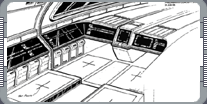 scheme, brushed aluminum accents, and so forth."
scheme, brushed aluminum accents, and so forth."
Although the speedboat was a major leap forward, Sternbach was careful to make sure that the exterior was
clearly related to these earlier shuttles. "The exterior was developed in just a few days, given the
form-and-function rules established for the boxy Type-6 and the shuttlepod, with new curves added from Voyager
itself. The simple, undetailed hull shape is the easy part; you take a hexagonal cross-section and pull the
surface lines more or less to a point in the front and a slightly blunter shape in the back where the door goes.
Hull curves could still be pushed and pulled to make the shuttle reconizably new and satisfy the 'cool'
requirement. The 'recipe' then says to add pylons and nacelles and sprinkle generously with the usual details.
There aren't too many reason to vary that Starfleet recipe within a particular story time period, unless a
directive comes down from the producers to evolve the technology ahead or add an alien flavor, as we have with
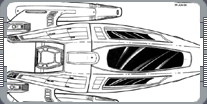 Borg bits in places like astrometrics and the Delta Flyer. Like other shuttles, speedboat had RCS thrusters, a
shield grid, phasers, nav deflector, and engine access hatches.
Borg bits in places like astrometrics and the Delta Flyer. Like other shuttles, speedboat had RCS thrusters, a
shield grid, phasers, nav deflector, and engine access hatches.
"The aft entry door differed a bit from the Type-6 shuttle door in that it split across the center, with one
half lifting up and the bottom dropping down to form a ramp. At one time we considered a flexible rollup piece
for the upper half, but a solid panel was easier to fabricate and move by hydraulics. We didn't need to build
to build the outer surfaces except in CGI, and when we did need to show in live shooting that the speedboat was
in the shuttlebay, all we had to do was place the correct style wall outside the door opening."
Sternbach's approach to the design was accepted at once, and the shape went through very few changes before the
model was built. Bunt, in order to complete the shuttle, his exterior design had to be integrated with the
interior Richard James and John Chichester were designing. Fortunately, Sternbach says, their design didn't
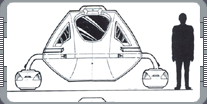 have any serious implications for the shape or size of the ship. "Unlike the Delta Flyer, whose exterior had
to be enlarged to fit its growing interior, the speedboat remained at a manageable 28 feet, give or take a few
inches. The overall shape was lower and narrower than the Type-6, but the length was similar."
have any serious implications for the shape or size of the ship. "Unlike the Delta Flyer, whose exterior had
to be enlarged to fit its growing interior, the speedboat remained at a manageable 28 feet, give or take a few
inches. The overall shape was lower and narrower than the Type-6, but the length was similar."
However, his design did evolve subtly to match the complete interior. "The first sketches of the exterior hull
were obviously produced before the set designers finalized the window and door shapes. I had sketched in
'placeholder' versions of the windows, which were close proportionally and in the right locations; those were
changed to the final versions during the blueprint stage. I also mirrored one of Chichester's ceiling curves on
the top of the speedboat to become the dorsal sensor array, so that was a nice of serendipity. We gave the
shuttle all of its basic interior parts; the seats, consoles, aft 'cargo hold,' windows, and lighting units.
Aside from the DS9 Runabout, we've almost never seen actual transporter hardware in a small craft. We've
assumed that the transport emitters were buried in the structure somewhere. The only little bottleneck was a
few days' delay on deciding how the aft entry hatch would operate, which impinged slightly on the exterior shape.
 Every step of the way, Tony Meininger's Brazil Fabrication model shop was kept in the loop with sketches, color
samples, and construction drawings."
Every step of the way, Tony Meininger's Brazil Fabrication model shop was kept in the loop with sketches, color
samples, and construction drawings."
As Sternbach points out, the speedboat shuttle marked the end of an era for Star Trek, because it was the first
time the art department didn't bother to build a full-sized version of the exterior that could be used on the
sound stage. On the few occasions we saw the shuttle in the shuttlebay, it was a CG model. The speedboat was
also last shuttlecraft that was built as a practical miniature before the show moved over to CG.
|
|
"DESIGNING THE TYPE-12 SHUTTLECRAFT" - SEPTEMBER 2001 ISSUE 29 STAR TREK: THE MAGAZINE COPYRIGHT OF PARAMOUNT
PICTURES.
|